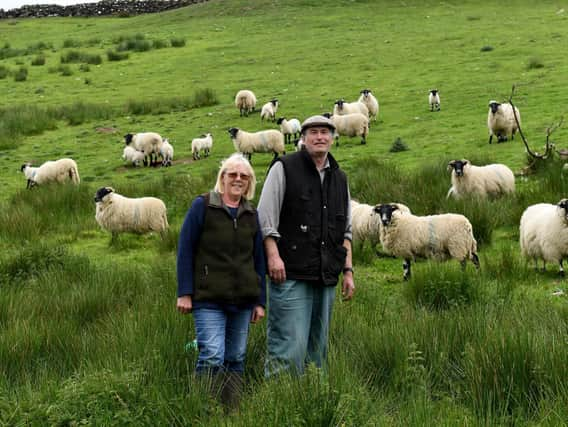The farmer turned driving instructor who is protecting moorland sheep.


This year is the 200th anniversary of a little-known organisation outside of the moors called the Blackface Sheep Breeders Association for the North Eastern region of North Yorkshire.
Such is its history it predates the more widely recognised and all-encompassing breed society of the Blackface Sheep Breeders Association formed in Lanark in August 1901.
Advertisement
Hide AdAdvertisement
Hide AdMartin is a fourth-generation moors farmer at Long Green Farm in Commondale and has represented the lesser-known society as chairman for the past 20 years, having served his apprenticeship as vice chairman for five years prior. The organisation has always primarily been about discussing issues that face their local farmer members.
“Probably one of our greatest achievements in the past few decades was getting moorland fencing on the Sleights to Pickering road at the top of Blue Bank,” says Martin. “We would like to get the Castleton to Hutton-le-Hole road fenced too. Most sheep farmers who have moors hefted flocks can lose up to 50 sheep a year through lambs and ewes killed on the roads.”
While this year’s traffic on the moors should be vastly reduced, given the lockdown restrictions, and should hopefully lead to a lessening of roadkill it is still an ongoing issue. Many visitors to the moors are captivated by sheep on country roads and lanes, but there are those who simply drive too fast not realising the damage they could bring about. Martin doesn’t believe it is always the driver at fault nonetheless.
“I wouldn’t say that it is always the motorist’s fault. If the lamb or lambs are split from their mothers and they hear a car approaching at whatever speed the lamb might suddenly run across the road, or the ewe might be trying to get to her lamb.
Advertisement
Hide AdAdvertisement
Hide Ad“We all want people to enjoy the countryside and we don’t want fencing to have to be there, because that’s all part of the freedom of the moorland, but there are stretches where it might be best to have it for everyone’s safety.”
Sheep breed associations are formed to promote a breed so that other farmers recognise its qualities, and while that is still one of the aims of the North Eastern region of North Yorkshire its 50 or so active members, that also include those who breed Swaledales, have been used to working as a collective on behalf of each others’ common day-to-day problems.
“Our association was initially set up to better enable the prosecution of felons, sheep rustlers,” says Martin. “Today it gives us all the opportunity to voice our concerns on current issues facing us as hill sheep farmers grazing on open moorland.
“We are involved with healthy sheep programmes to keep the tick population down, input into higher level stewardship schemes and how any new schemes will operate on moorland, and hill farming support.”
Advertisement
Hide AdAdvertisement
Hide AdPerhaps the most useful document of all is the association’s Mark Book. This is a directory to every hill farmer’s sheep markings. These are the sprayed-on colours you see on each sheep on the moors. The distinction between each is the colour and where the spray is applied on the sheep.
“For those with sheep around Commondale my sheep are distinguished by blue down one flank, Derek Harding’s have green on their backs, Judith Robinson’s are red on their loins and Ian Martin’s are red across their shoulders. That allows for ease of identification from a distance and then each sheep also has its unique tag with its unique number and an ear mark.
“Moorland sheep are hefted to their area, which means they very rarely stray but as and when they do that’s when the book becomes particularly handy and it is referred to regularly. We had a couple a few years ago that had turned up a good few miles further away on Guisborough Estate land.”
Martin farms across 120 acres of in-bye as well as having moorland rights. His farming operation starts with his 100 pedigree Blackface ewes that produce Blackface lambs for replacements to his pedigree flock and as ewes to be put to the Bluefaced Leicester tup to produce the North of England Mule.
Advertisement
Hide AdAdvertisement
Hide AdHe has 120 Blackface ewes put to the Bluefaced Leicester each year. These produce the Mule ewes that are then crossed with the Texel to produce the bigger carcase lamb for the meat market. It is only the pedigree Blackface flock that goes on the moors. “Ours, like most of our members, is a closed flock. We buy tups from the breed sales in Ruswarp and Hexham in October each year; and we use Ruswarp for all our lamb and cull ewe sales.
“Blackface sheep breeders and Swaledale breeders are very loyal to their breeds and you don’t see many switching. The Muirs are the longest-serving family in the association at present, but we don’t go back to 1820 which is when there is the earliest recorded minute book.
“Today we meet in either The Lion on Blakey Rigg or the Inn On The Moor in Goathland where we regularly have 20-25 attendees. It is more difficult attracting younger members as many sons, like our son John, now work away, but we all know how important it is to keep the association moving forward.”
In addition to Martin’s sheep enterprise he also runs a herd of 20 suckler cows put to a Limousin bull and has diversified into an area that sees him assisting with the future safety of Blackface sheep on the moorland roads.
“I’m now a driving instructor, hopefully that will also make sure the young people I teach have even more of an understanding of care on our country lanes.”